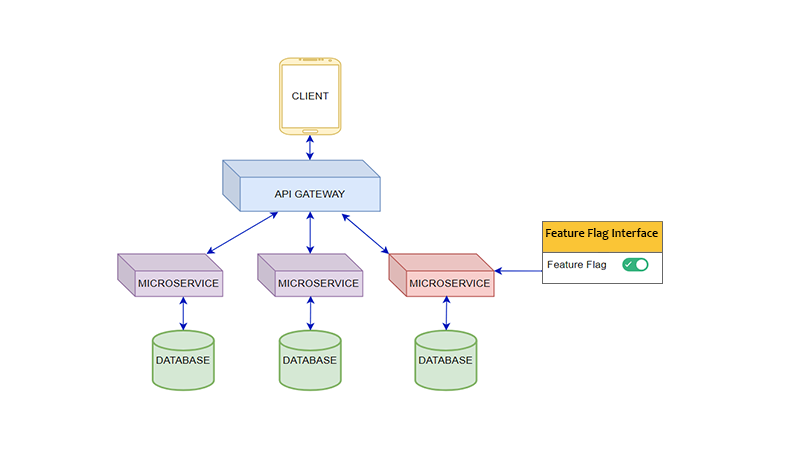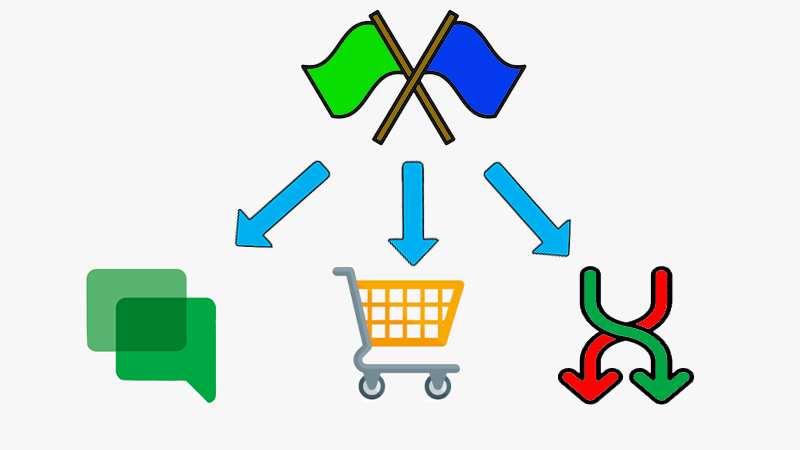Why You Should Use Feature Flags in a Microservices Architecture
Microservices Architecture is a revolutionary approach to software development that empowers applications to scale and evolve with unparalleled flexibility. But: How do feature flags help in this dynamic landscape of microservices?

What is a Microservices Architecture?
Microservices architecture is a software development approach that organizes an application as a collection of loosely coupled and independently deployable services.
Each service represents a distinct business capability or functionality and operates as an independent process. This enables individual services to scale independently according to demand. Microservices communicate with one another through lightweight protocols such as HTTP/REST, messaging brokers, or event-driven mechanisms.
Thanks to their independent design, services are autonomous and self-reliant, allowing developers to work in separate teams for development, deployment, and scaling. This enhances the overall system's fault tolerance since failures in one service don't necessarily impact the entire application. Moreover, different technologies can be employed to develop various services, empowering teams to select the most suitable tools for their specific requirements. Making this development approach a preferred choice for building large, robust, and reliable systems.
What are Feature Flags?
Feature flags, also known as feature toggles, are a technique used in software development to enable or disable certain features in an application. By using feature flags, developers can easily turn features on or off at runtime without code re-deployment.
Benefits of Using Feature Flags in a Microservices Architecture
Feature flags offer numerous advantages in a microservices architecture. They empower organizations to have more control over the development process and release management. Let's explore some key benefits:
Independent Development of Features
One of the primary advantages of feature flags in a microservices architecture is the ability to develop features independently. Unlike monolithic architectures where all features are tightly coupled, microservices allow each service to be responsible for a specific capability. By leveraging feature flags, developers can enable or disable these features without affecting the rest of the system.
Risk Reduction and Releases Control
Another significant benefit of utilizing feature flags in a microservices architecture is the reduction of risks associated with releases. In distributed systems, introducing a new feature can lead to unexpected issues that disrupt the entire application. However, by using feature flags, organizations can gradually roll out features to a subset of users and closely monitor their performance. Should any issues arise, the feature can be quickly disabled, mitigating the risk of widespread failures, providing better control over the release process.
Enhanced User Experience and Testing Capabilities
Feature flags also play a crucial role in delivering enhanced user experiences. They enable organizations to provide personalized experiences to different user segments by selectively enabling features for specific groups. This empowers organizations to conduct targeted testing, gather user feedback, and validate assumptions before fully releasing the feature. Moreover, feature flags facilitate A/B testing, allowing data-driven decisions to optimize the user experience.
Integration of Feature Flags with the Microservices Architecture

The two solutions to integrating feature flags into a microservices architecture are:
- building a custom solution,
- or using an external feature flag platform.
There are several external options to choose from. Some popular ones include LaunchDarkly, Split, and ConfigCat. These tools provide a user-friendly interface for managing feature flags, and offer features such as targeting rules, audit logs, and integration solutions with popular frameworks.
Below, I outlined some points to bear in mind when integrating feature flags into a microservices architecture:
1. Establish a Centralized Feature Flag Service:
The first crucial step is to create or use a third party feature flag management system. This system will handle the configuration and management of feature flags across the entire microservices system. It should provide APIs that allow enabling or disabling specific features for different services or individual users. Centralizing feature flags ensures consistency, ease of management, and seamless feature toggling.
2. Integrate the Feature Flag SDK into Microservices:
Next, it's essential to integrate the target microservice with the feature flag SDK. This SDK should allow the microservice to check the status of the feature flags at runtime. By integrating the SDK, microservices can dynamically request the current status of a feature flag and adjust their behavior accordingly. This decouples feature activation from the codebase, making it easier to control the feature rollout without modifying the microservices' source code.
3. Define a Thoughtful Rollout Strategy:
Every feature should come with a well-defined rollout strategy. This strategy specifies whether a feature should be enabled or disabled by default and outlines the criteria for gradual expansion. Depending on the nature of the feature and its potential impact on the system, rollout strategies can include options like percentage-based rollout, targeting specific user segments, or releasing in specific environments.
4. Implement Monitoring and Analytics:
To make informed decisions about feature releases and gauge their impact, it's crucial to implement comprehensive monitoring and analytics. This includes tracking the usage and performance of different features across microservices. Monitoring allows for identifying potential bottlenecks or issues in real time, enabling timely interventions. Additionally, analytics help measure the impact of new features on user behavior, conversion rates, and overall system performance. By leveraging data-driven insights, optimizations can be conducted on the feature development process, thus continuously enhancing the user experience.
Use Cases of Feature Flags in Microservices Architecture
Feature flags offer a wide range of use cases within a microservices architecture, enabling organizations to optimize their development and deployment strategies. For example, let's take an e-commerce platform and explore how feature flags can be applied in this context:

Feature Testing and Validation
Let's consider an e-commerce platform introducing a new live chat customer support service. By using feature flags, the maintainers can release the service to a small group of users initially, allowing them to test and validate its functionality in a controlled environment before rolling it out to all shoppers. This approach ensures that any potential issues are ironed out, and the overall user experience remains smooth.
Canary Releases and A/B Testing
Now, imagine the same e-commerce platform is implementing a new checkout process. With feature flags, they can roll out this updated checkout experience to a small percentage of users first or perform an A/B test. By doing so, they can monitor user behavior, and track conversion metrics. This allows them to make data-driven decisions about the effectiveness of the new checkout process before making it available to all customers.
Phased Rollouts and Kill Switches
Lastly, let's examine how feature flags assist in phased rollouts and emergency management for our e-commerce platform. Suppose the platform is launching a new personalized product recommendation feature.
By using feature flags, they can incrementally enable this feature for a larger user base, starting with a small segment of customers. This phased approach allows the platform to assess the feature's impact, identify scalability concerns, and gather user feedback to fine-tune the recommendation algorithm. Additionally, in case of critical failures or unexpected issues, feature flags provide a safety net.
The platform can quickly disable the feature flag, reverting to the previous stable version and ensuring an overall better shopping experience for all users.
While I used an e-commerce platform as an example, it's important to note that feature flags can be applied across various types of applications and scenarios adopting a microservices architecture. These flags empower organizations to deploy features more confidently, gather valuable data, and respond agilely to user needs and feedback.
Conclusion
Integrating feature flags into a microservices architecture offers a range of benefits. It enables independent development of features, reduces release risks, and enhances user experience through targeted testing. Feature flags provide the flexibility to gradually roll out features and quickly address issues with kill switches.
Overall, feature flags promote scalable and adaptive applications, keeping them at the forefront of software development. Deploy any time, release when confident.
Follow ConfigCat on Twitter, Facebook, LinkedIn, and GitHub for more posts like this and other announcements.
